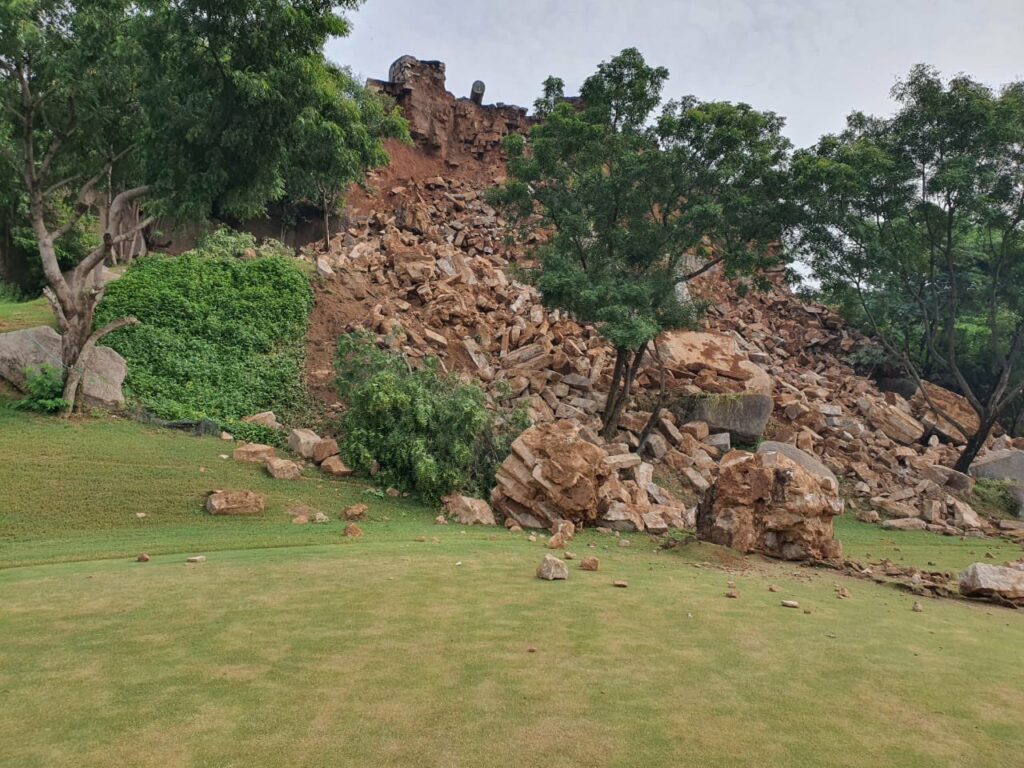[ad_1]
Hyderabad: A minor scuffle broke out in front of the Golconda Fort’s Naya Qila are in the early hours on Tuesday when a few unidentified drunk men attacked Archaeological Survey of India (ASI) the golf course security personnel who were manning the entry gate. The assailants demanded entry into the Naya Qila area, and reportedly beat up the guards, a few of which were taken to a hospital nearby for treatment.
Interestingly, additional security was posted at Naya Qila by the ASI after the Hyderabad Golf Course Association (HGA) started expansion works without permission from the authorities a day earlier. Officials said that while the ASI accepted the golf course’s request to allow expansion, the landscaping work required for it would require permission from the ASI without fail. As none was taken, the ASI intervened and got it stopped.
It may be noted that activists have from years questioned how ancient historic land of the Golconda fort was given to private organisations like the HGA.
The additional 24-hour security was posted at Naya Qila for that purpose. However, unexpectedly, the known assailants landed up at the location and demanded entry into Naya Qila. Officials from the Golconda police station have also been informed, and a formal written complaint will be given soon, said ASI officials. The cops are reportedly on the lookout for the attackers. It is unsure what their exact motive was, but it is suspected that they are anti-social elements from the surrounding areas
Naya Qila history
The Naya Qila area is in fact believed to be about over 400 years old, and is a part of the Golconda dynasty’s (which founded Hyderabad in 1591) remaining heritage in Hyderabad. The Naya Qila area, which is now cut-off from the Golconda fort due to local encroachments, was developed into an external fortification after the first Mughal attack (during the time of Emperor Shah Jahan) on Hyderabad in 1656.
It has two huge bastions called Laila and Majnu, of which Majnu continues to be in a state of disrepair after its collapse during monsoons in 2021. The ancient historic site was one of the few places which witnessed damage during heavy rains in 2021 in the fort. The Archaeological Survey of India (ASI), which runs the historical site, was supposed to undertake repairs, but that has not happened so far as well.

Other parts of Naya Qila which are open to the public are the Baobab tree, which is believed to be over 400 years old (it is said to have been planted there by African friars), the Mustafa Khan Masjid (which was built in 1561 and predates Hyderabad), and the Mulla Khyali Masjid, which is believed to be named after the Deccan poet Mulla Khyali.
While the Majnu Bastion’s collapse is the latest instance of the city’s heritage getting damaged, in the past the HGA had also disallowed the general public from entering the Naya Qila area. However, according the ASI, there is no such restriction and the public is free to visit the place.
The Golconda Fort and the Charminar are two monuments that fall under the jurisdiction of the ASI, which works the central government, while all the other heritage sites like the Qutb Shahi Tombs come under the purview of the Archeology Department of Telangana government. Last year, a petition A petition was also created to save Naya Qila and the Golconda fort by local Hyderabadis.
History of Golconda Fort
The Golconda Fort’s origins are traced back to the 14th century when the Rajah of Warangal Deo Rai (under the Kakatiya Kingdom which ruled from Warangal) built a mud fort. It was taken over by the Bahmani Empire between 1358 and 1375. Later, it was developed into a full-fledged citadel by Sultan Quli who founded the Qutb Shahi kingdom in 1518 following the death of last sovereign of Bahmani Emperor Mahmud Shah.
Sultan Quli was a commander and later governor of Tilang (Telangana), under the Bahmani Empire (1347-1518), when its second capital was at Bidar. Sultan Quli, who was originally from Hamadan in Iran, rose to the level of Governor under the Bahmani Empire in early 16th century. At this point of time he was given the fort, around which he began developing a walled-city. It eventually came to be called Golconda Fort (name derived from Telugu Golla-conda, or shepherds hill).
The fort has 87 bastions, and eight gates, of which a few are not accessible to the general public as they are under the army control. It is believed to be one of the Deccan’s most impregnable forts, and had kept Mughal emperor Aurangzeb’s army at bay for eight months until he succeeded and conquered Hyderabad in 1687.
Hyderabad was founded in the year 1591 by Mohd. Quli Qutb Shah, the grandson of Sultan Quli, with the Charminar being the city’s foundation. The city turned 429 years old in 2020.
[ad_2]
#Hyderabad #Security #Golconda #Forts #Naya #Qila #attacked
( With inputs from www.siasat.com )

Leave a Reply